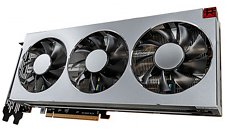- Joined
- Oct 9, 2007
- Messages
- 47,528 (7.48/day)
- Location
- Hyderabad, India
| System Name | RBMK-1000 |
|---|---|
| Processor | AMD Ryzen 7 5700G |
| Motherboard | ASUS ROG Strix B450-E Gaming |
| Cooling | DeepCool Gammax L240 V2 |
| Memory | 2x 8GB G.Skill Sniper X |
| Video Card(s) | Palit GeForce RTX 2080 SUPER GameRock |
| Storage | Western Digital Black NVMe 512GB |
| Display(s) | BenQ 1440p 60 Hz 27-inch |
| Case | Corsair Carbide 100R |
| Audio Device(s) | ASUS SupremeFX S1220A |
| Power Supply | Cooler Master MWE Gold 650W |
| Mouse | ASUS ROG Strix Impact |
| Keyboard | Gamdias Hermes E2 |
| Software | Windows 11 Pro |
AMD "Navi" is the company's next-generation graphics architecture succeeding "Vega" and will leverage the 7 nm silicon fabrication process. It was originally slated to launch mid-2019, with probable unveiling on the sidelines of Computex (early-June). Cowcotland reports that AMD has delayed its plans to launch "Navi" all the way to October (Q4-2019). The delay probably has something to do with AMD's 7 nm foundry allocation for the year.
AMD is now fully reliant on TSMC to execute its 7 nm product roadmap, which includes its entire 2nd generation EPYC and 3rd generation Ryzen processors based on the "Zen 2" architecture, and to a smaller extent, GPUs based on its 2nd generation "Vega" architecture, such as the recently launched Radeon VII. We expect the first "Navi" discrete GPU to be a lean, fast-moving product that succeeds "Polaris 30." In addition to 7 nm, it could incorporate faster SIMD units, higher clock-speeds, and a relatively cost-effective memory solution, such as GDDR6.

View at TechPowerUp Main Site
AMD is now fully reliant on TSMC to execute its 7 nm product roadmap, which includes its entire 2nd generation EPYC and 3rd generation Ryzen processors based on the "Zen 2" architecture, and to a smaller extent, GPUs based on its 2nd generation "Vega" architecture, such as the recently launched Radeon VII. We expect the first "Navi" discrete GPU to be a lean, fast-moving product that succeeds "Polaris 30." In addition to 7 nm, it could incorporate faster SIMD units, higher clock-speeds, and a relatively cost-effective memory solution, such as GDDR6.

View at TechPowerUp Main Site





